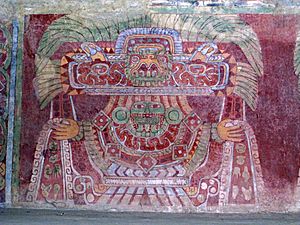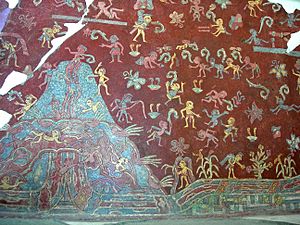Great Goddess of Teotihuacan facts for kids
The Great Goddess of Teotihuacan (or Teotihuacan Spider Woman) is a proposed goddess of the pre-Columbian Teotihuacan civilization (ca. 100 BCE - 700 CE), in what is now Mexico.
Contents
The Great Goddess
Defining characteristics of the Great Goddess are a bird headress and a nose pendant with descending fangs. In the Tepantitla and Tetitla murals, for example, the Great Goddess wears a frame headdress that includes the face of a green bird, generally identified as an owl or quetzal, and a rectangular nosepiece adorned with three circles below which hang three or five fangs. The outer fangs curl away from the center, while the middle fang points down. She is also always seen with jewelry such as beaded necklaces and earrings which were commonly worn by Teotihuacan women. Her face is always shown frontally, either masked or partially covered, and her hands in murals are always depicted stretched out giving water, seeds, and jade treasures.
Other defining characteristics include the colors red and yellow; note that the Goddess appears with a yellowish cast in both murals.
In the depiction from the Tepantitla compound, the Great Goddess appears with vegetation growing out of her head. Spiders and butterflies appear on the vegetation and water drips from its branches and flows from the hands of the Great Goddess. Water also flows from her lower body. These many representations of water led Caso to declare this to be a representation of the rain god, Tlaloc.
Below this depiction, separated from it by two interwoven serpents and a talud-tablero, is a scene showing dozens of small human figures, usually wearing only a loincloth and often showing a speech scroll (see photo below). Several of these figures are swimming in the criss-crossed rivers flowing from a mountain at the bottom of the scene. Caso interpreted this scene as the afterlife realm of Tlaloc, although this interpretation has also been challenged, most recently by María Teresa Uriarte, who provides a more commonplace interpretation: that "this mural represents Teotihuacan as [the] prototypical civilized city associated with the beginning of time and the calendar".
Domain
The Great Goddess is thought to have been a goddess of the underworld, darkness, the earth, water, war, and possibly even creation itself. To the ancient civilizations of Mesoamerica, the jaguar, the owl, and especially the spider were considered creatures of darkness, often found in caves and during the night. The fact that the Great Goddess is frequently depicted with all of these creatures further supports the idea of her underworld connections.
In many murals, the Great Goddess is shown with many of the scurrying arachnids in the background, on her clothing, or hanging from her arms. She is often seen with shields decorated with spider webs, further suggesting her relationship with warfare. The Great Goddess is often shown in paradisial settings, giving gifts. For example, the mural from Tepantitla shows water dripping from her hands while in the tableau under her portrait mortals swim, play ball, and dance (see photo to right). This seeming gentleness is in contrast to later similar Aztec deities such as Cihuacoatl, who frequently has a warlike aspect. This contrast, according to Esther Pasztory, an archaeologist who has long studied Teotihuacan, extends beyond the goddesses in question to the core of the Teotihuacan and Aztec cultures themselves: "Although I cannot prove this precisely, I sense that the Aztec goal was military glory and staving off the collapse of the universe, whereas the Teotihuacan aim seems to have been the creation of paradise on earth."
This is not to say, however, that the Great Goddess does not have her more violent aspect: one mural fragment, likely from Techinantitla, shows her as a large mouth with teeth, framed by clawed hands.
Similar deities
Some American Indians, such as the Pueblo and Navajo, revered what seems to be a similar deity. Referred to as the Spider Grandmother, she shares many traits with the Teotihuacan Spider Woman.
See also
 In Spanish: Gran Diosa de Teotihuacán para niños
In Spanish: Gran Diosa de Teotihuacán para niños



